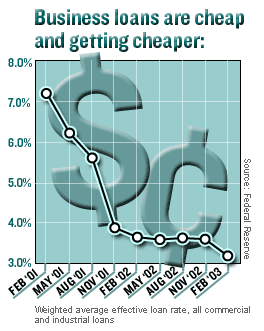NEW YORK (CNN/Money) - Super-low interest rates have fueled a wave of mortgage refinancing and cheap auto loans that have kept the sluggish economy from getting even weaker, even while businesses grumpily sit on the sidelines, refusing to hire new workers or expand their operations.
But recent bank-loan data show that, despite super-low rates, rising stock prices and a general hope that the economy will gain strength in the second half of the year, businesses still aren't borrowing.

Some economists say this could be a sign that the business-investment slump, which has kept economic growth sluggish for years, might linger for quite a while longer. Others say it's simply the last relic of the downturn and that businesses are raising funds in other ways.
First, the facts: The dollar value of all commercial and industrial loans outstanding at U.S. commercial banks fell to $931.8 billion in the last week of May, the Federal Reserve reported recently, the lowest level since September 1998.
And businesses are fleeing from bank loans even though lending rates are low and getting lower. According to the Fed's latest survey of business lenders, the weighted average interest rate for all business loans was 3.20 percent in February, the lowest since the Fed started keeping track back in 1986.
"Business firms are still unwilling to take advantage of this low rate structure," Morgan Stanley senior economist Bill Sullivan said in a recent research note. "The failure to borrow could be a hint that business planners do not foresee a significant resurgence in the economy over the quarters to come."
You can lead a horse to water...
Anirvan Banerji of the Economic Cycle Research Institute, which publishes a weekly index of leading economic indicators, said business loan activity can be a forerunner of business spending -- and recent data are consistent with what seems to be a lousy environment for spending.

Banerji said he thinks spending depends on "three Cs" -- cash, confidence and capacity. With interest rates low, the recent tax breaks for business and corporate profits improving, there's plenty of cash available.
And corporate confidence, after plunging around the war with Iraq, has recovered somewhat -- companies are merely gloomy, rather than on suicide watch.
The biggest problem, then, is capacity. There's just too much of it.
After a spending frenzy in the late 1990s, businesses ended up with too much production capacity and a healthy dose of debt to go along with it. Until these problems are cleared up, Banerji and other economists worry, no amount of liquidity is going to convince businesses to start borrowing or spending again.
"There is not yet a lot of impetus for business investment," Banerji said. "You can lead a horse to water, but you cannot make him drink."
Banerji said the spending slump could continue through this year, stretching out the sub-par recovery from the 2001 recession for some time.
Cash from other sources
Still, it's possible that business loans could pick up in a hurry. If businesses decide they see a jump in demand, they might run to their local banker and get the short-term loans they need to start building inventories.
"This is more of a contemporaneous indicator -- if business picks up and firms find they need to stock more inventory, we will see lending pick up," said Kevin Logan, senior market economist at Dresdner Kleinwort Wasserstein, who expects some pick-up in activity this year, but not a lot.
What's more, with rates on longer-term corporate bonds falling, many firms are finding it more cost-effective to raise cash by selling bonds, which last longer than commercial loans, meaning they can lock low rates in for longer stretches of time.
Meanwhile, bank credit for other uses -- especially home mortgages -- is on the rise, and tax cuts could also provide another small boost to consumers' pocketbooks.
Some of this cash will obviously be spent on goods made overseas, and some will be saved. But some of it will make its way to domestic businesses, potentially encouraging more investment and hiring.
"There's a lack of confidence showing through" in business lending data, said Anthony Crescenzi, bond analyst at Miller Tabak & Co. But, he added, that seems "inconsistent with all other evidence of an explosion of liquidity since April. I think the data will improve over time."
Of course, "improvement" could mean a lot of things, and many economists think the kind of robust growth in jobs and economic activity seen in the late 1990s is still a long, long way away.
"Essentially, what this amounts to is still no big V-shaped recovery of the kind that we've been promised for the past three years," said Banerji of the ECRI. "On the other hand, we're not headed back to recession. We'll steer the middle course, which doesn't make for good headlines."

|

